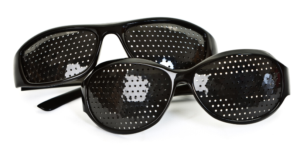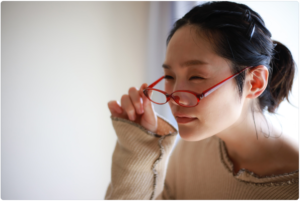You’ve maybe noticed that if you really want to see more detail, squinting can help! Whether it’s a street sign or a menu, squinting can get you through. One question we get every day is… how does it even work? It’s all related to the mechanics of light, so we’ll explain.
How Does The Eye See?

This animation shows the main components of light focusing in the eye. Light enters through the clear cornea and then through the clear crystalline lens. In the ideal situation, the light of whatever you’re looking at focuses perfectly on the retina. This is the light sensitive tissue of the eye, which converts the light into nerve impulses to be sent to the brain for processing.
When the light rays aren’t focused on the retina, you see a blurred image. The purpose of glasses or contact lenses is to focus the light on the retina.
Natural Focus
When we’re young, our eyes have two major ways to change our focus. The first is the pupil can change size. When you’re looking at near objects, your pupil naturally shrinks. This makes the majority of the light coming in land directly on your macula. This part of your eye is responsible for detail and color vision, the rest of your eye is for night and peripheral vision.
Consider the next picture here, showing that narrower light beams entering the eye are more focused.

And now to look at how a point of light looks with various pupil sizes. Notice now much more scattered the single point becomes with larger pupil sizes.

The other way our eyes naturally focus is by flexing the shape of the crystalline lens inside the eye.

The Pinhole Effect
Pretty much everyone has a “refractive error“, which means when light refracts (bends) through the clear cornea and lens, they don’t focus perfectly on the macula. The light can either converge in front of the macula (near-sighted) or not completely converge before it hits the macula (far-sighted).

To add to this, sometimes the eye is a little misshapen, which we call “astigmatism“. With astigmatism, light ends up with two focal points inside your eye.
A pinhole is just as it sounds, a small hole that you can look through. Because the opening (aperture) is small, it increases your depth of field, which is how many things are in focus. Just as a smaller pupil provides more focus, so does a pinhole.
So Why Does Squinting Work

When you squint, the eyelids partially close over the eye, creating a sort of pinhole. This has the same effect and is a quick way to help bring things into focus.
As we’ve covered, squinting is just trying to get light to focus on the retina properly. And it will work, but it’s rather inconvenient. Dermatologists say that repeated squinting can cause extra wrinkles, too.
A more permanent way to get light to focus properly is to have the correct glasses or contact lens prescription, or consider a procedure like LASIK.
Some people have an irregular shaped astigmatism that cannot be well corrected by glasses alone. This condition requires special contact lenses, so even with brand new glasses, they may find that squinting still helps.
Our doctors are ready to help if you find you’re squinting more than you’d like!